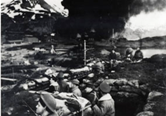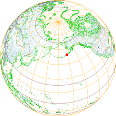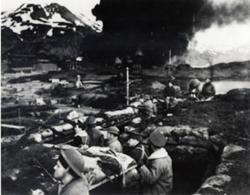-
Government
City Services-
DepartmentsCity Manager Administration City Clerk Finance Fire Department Human Resources Library Parks Culture and Recreation Planning Ports and Harbors Public Safety Public Utilities Public Works
-
Mayor & City CouncilMayor & Council Agendas and Minutes Meeting Schedule Public Comment at Meetings Ordinances Resolutions Trip Reports City Code Annual Budget Lobbyist Reports Staff Directory
-
Committees & CommissionsHistoric Preservation Commission Library Advisory Committee Parks, Culture & Recreation Committee Planning Commission Apply to ServeElection InformationRegistering to Vote Polling Location Absentee Voting FAQ

Did You Know?
Did you know that the waters around Unalaska Island are one of the few places in the world to find the rare Whiskered Auklet?
-
-
Commerce
Port/Business-
PortPort Department Dock Facilities and Services AirportFisheriesCommercial Fishing Seasons Sport Fishing Seasons Fisheries Links Fisheries Reports Fish Species common in Alaska
-
BusinessBids and RFPs Business Directory Business Licensing Community Profile Economy Forms and Permits Shipping & Cargo Taxes Unalaska Visitors Bureau
-
TaxesPersonal Property Taxes Real Property Taxes Sales Taxes

Did You Know?
Did you know that Unalaska/Dutch Harbor was bombed by the Japanese during WWII?
-
-
Community
Residents/Visitors-
About UnalaskaCommunity Profile Economy Frequently Asked Questions History Is it Unalaska or Dutch Harbor? Passenger Transportation Photo Galleries Plants Population Shipping and Cargo Weather Wildlife WWII in the Aleutians
-
VisitorsVisitor Bureau Library Museum of the Aleutians Parks & Trails Passenger Transportation Sport Fishing Seasons Things To See & Do Tour Operators WWII National Historic Area and Visitor Center
-
ResidentsAnnual Festivals and Events Community Calendar Emergency Preparedness Health Care Library Non Profits & Community Services Parks & Trails Recreation Schools Sport Fishing Seasons

Did You Know?
Did you know that Unalaska is 800 miles from Anchorage and farther West than Hawaii?
-
-
I want to...
Help Center-
ApplyJob Board/Commission Building Permit Burn Permit Business License Fireworks Permit Pet LicenseContactStaff DirectoryRequestPublic Records Public Safety Records Utility Service
-
PaymentsUtilities TaxesRegisterVoter Registration Vehicle RegistrationReportBuilding Code Violation Road Maintenance Issue Street Light Outage Animal Control Issues
-
ViewAgendas and Minutes Annual Budget Bids & RFPs Code of Ordinances Calendar of Meetings Community Events Documents, Reports, & Presentations Forms, Permits & Applications Property Parcel Info Schedule of Fees & Charges

Did You Know?
That Unalaska’s Port of Dutch Harbor is the #1 Commercial Fishing Port in the United States, based on quantity of the catch and has been for more than 20 years?
Find Out More-
World War II in the Aleutians
By: Jeff Dickrell
The impact of World War II in the Aleutian Islands remains one of the most visible features that dot this remote landscape today. Quonset huts, barracks, and former gun emplacements blend with Unalaska's modern physical features, providing visitors and locals alike with a unique opportunity to explore this part of United States history. For more on World War II in the Aleutians please visit the Aleutian World War II Visitor Center, the Ounalashka Corporation and the Museum of the Aleutians.
The United States military paid little attention to the Aleutian Islands prior to WWII. A naval exercise in 1938 was a disaster due to weather, and Navy PBY airplanes were allowed to fly out only in summer. A treaty with Japan forbade the building of bases in the island chain. All of this changed in 1934 when Japan announced it would abandon the treaty. The U.S. Military began looking in earnest at the options for base building.
The decision to use Dutch Harbor as the main naval base did not come easily. Little flat ground and a harbor that was too small for turning vessels were balanced by the fact that the navy already had a radio station and weather observatory in place here. The private buildings that made up the village of Dutch Harbor were bought and construction began in the summer of 1940. Six months later, the Naval Section base was commissioned, with an air station completed by September 1941. When the war began for the United States in December of that year, the base at Dutch Harbor was ill defended. Only a major artillery position on Ballyhoo Mountain was completed.
In May 1942, a Japanese naval force of two aircraft carriers and several smaller ships steamed 180 miles southwest of Unalaska Island. Their mission was to neutralize the air base at Dutch Harbor and destroy its ability to attack Japan. In a strange compromise, due to the lack of flat ground, American airfields had been built 100 miles east, at Cold Bay, and 80 miles west, on Umnak Island, Cape Field. On June 3rd, at 6:00 a.m., eleven Kate bombers and six Zero fighters attacked the base. The Americans, having broken the enemy code, were prepared. Finding no airfield, the planes dropped their bombs on the Army barracks of Ft. Mears. This tightly packed cluster of white buildings housed most of the 9,000 men on the island. More bombs fell on radio stations and anti-aircraft positions. No Japanese planes were shot down. Strangely, communication with the American airfields failed during the attacks. No planes came to the defense of Dutch Harbor. Over the next 24 hours, American aircraft searched for the Japanese. A few unsuccessful attacks were made against the small fleet.
On June 4th, Dutch Harbor was attacked again by eleven Zeros, nine Kates and an additional punch of eleven Val dive-bombers. Having photographed the base the previous day, the Japanese dropped bombs that destroyed fuel tanks, and a ship used for power generation (the Northwestern), as well as smaller random targets. Once again, communication with the American airfields failed. In total, less than fifty men were killed in action.
As the Japanese steamed away westward, the Americans made two important decisions. Priority one was to build a runway in Dutch Harbor. This was done in nine days and is still used today. The second was to evacuate the native Unangan (Aleut) people from the entire island chain. The decision was ill planned and carried out with no regard for the victims' well being. Eight hundred eighty-one people from eight villages were sent to makeshift camps in southeast Alaska. There the discomfort and lack of care resulted in high death rates among the youngest and oldest of the culture, losses that are still felt today. A week after the attacks on Unalaska, the Americans discovered that the Japanese had occupied two islands on the western end of the chain, Attu and Kiska. A concentrated attempt to bomb the enemy from the islands failed, so a new tactic was developed. This was the building of airfields closer and closer to the enemy-held islands. By the end of August 1942, a major base was opened on Adak Island. This shifted operations from Unalaska further west. The base at Dutch Harbor soon became a minor support center.
A year after the Japanese attacks on Dutch Harbor, the Americans invaded Attu, and in nineteen days of heavy fighting cleared it of the enemy. Two months later, the Americans landed on Kiska expecting the same fanatical resistance. Instead, they discovered the Japanese had evacuated their entire force. This ended the Aleutian Campaign but not the American presence on Unalaska, which lasted until the war ended.
________________________________________________
See the two related photo galleries: WWII and Remnants of WWII

